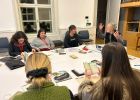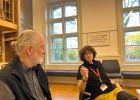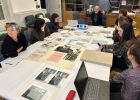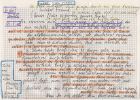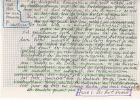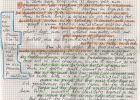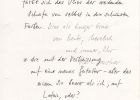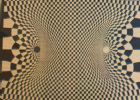Entre a Memória e o Abismo: regimes de hipermemória, datificação e a arte como desprogramação na cultura de dados /Between Memory and the Abyss: Hypermemory Regimes, Datification and Art as Deprogramming in Digital Culture
This essay investigates transformations of memory in the context of digital culture, datafication, and algorithmic control, proposing the notion of a hypermemory regime to describe the contemporary reconfiguration of how memory is produced, stored, and monetised. Structured in three interconnected parts, the text begins by critically examining how memory has become a strategic field of dispute in the age of surveillance capitalism. Through the commodification of data and algorithmic governance, memory is no longer merely a human or cultural attribute—it is now central to new systems of power and behavioural control. In the second part, the essay turns to Vilém Flusser’s philosophical contributions—especially the texts Ars Memoria, Vampyroteuthis Infernalis, and Filosofia da Caixa Preta [Towards a Philosophy of Photography]—to rethink the technical, symbolic, and ideological dimensions of memory. Flusser’s reflections anticipate many of today’s central concerns and offer critical tools for understanding the mediating role of artificial memories. Finally, the third part explores how art, through gestures of deprogramming, can act as a space of resistance within the hypermemory regime. For Flusser, to remember is not only to preserve but also to invent—to reopen experience to imagination, criticism, and freedom.
Reading Flusser: An Abecedarium
This is a memoir of the writer's reading relationship to Flusser over roughly twenty years. It represents an effort to sift through a wide variety of tangled thoughts and associations to locate those topics and approaches characteristic of Flusser that remain most promising, that is, have potential to stimulate further research or new interest. Although it does characterise Flusser's work broadly as an ongoing engagement with alphabetic writing, its history, relationships with other communicative codes, identity with history as such, conflict with other codes, it does not draw any one overall conclusion. Flusser's ongoing impact is rather seen to emerge from the distinctive way the writing engages its reader -- questioning, challenging, often persuading. Reading Flusser includes observations about the specific effects of Flusser's writing on this reader in particular, about recent research that confirms or amplifies certain pivotal ideas in the broader framework of his thought -- particularly with respect to reading and writing, and some evidence of how his thinking enters into at least one reader's perceptions of contemporary events. The abecedarium, an archaic poetic form that gathers aspects of a topic around specific words or phrases and presents them in alphabetical order, seems suited to compressing a diversity of material into an orderly form.
Vilém Flusser nas vizinhanças do niilismo e para além
The question of nihilism implies a return to Nietzsche. In this article this return is briefly made only to the extent that it is possible to find a connecting thread between Nietzsche and Flusser with regard to nihilism. Prepared as a dialogue essay with other interpreters of Flusser, selected based on their contributions to specific themes that are put into discussion, this article aims to highlight the fact that nihilism is, for Flusser, just a starting point with a view to its overcoming. This does not mean to deny that Flusser focused on concepts neighboring nihilism such as doubt and skepticism. However, these neighborhoods do not prevent Flusser from finding foci of hope in the playful power of the human that materializes in the arts, conceived as emancipatory inebriation.
ACTIVE – ARCHIVE – RESEARCH
This essay aims to sum up the preliminary conceptions and the results of an archival research and research lab which was conducted and organized by the author at Artpool Art Research Center, Budapest, in the autumn of 2023, and supported by the Museum of Fine Arts with the participation of seven young researchers. Artpool – this unique artist-archive, presently art research center – also called “active – archive – research”, using Galántai’s term invented in 1979, was founded by him, his wife, and the fellow artist Júlia Klaniczay. Their personal presence in the lab’s research work, “the thought-exchange” – as Galántai understands teaching/learning – provided an opportunity to develop a new research method based on Michael Polanyi’s personal knowledge theory. The essay also highlights the possibilities of exploring parallels between Vilém Flusser’s and György Galántai’s thinking and opens up new perspectives for further research.
Um alfabeto de azuis e amarelos
In the interview “Um alfabeto de azuis e amarelos” (An alphabet of blues and yellows) published by the magazine “Superinteressante” in November 1988, Flusser discussed his theoretical position. The problem with spoken and written languages is that they are inadequate to describe the world, which could be described much better in mathematical terms. However, the problem with numbers is that they are separated from each other by intervals. Colours, on the other hand, tend to blend into each other.
Letters / Farben statt Formen / Coloration replacing formalisation / Farben verschlüsseln / Karl Gerstner / Vilém Flusser und die Farben
Vilém Flusser and Karl Gerstner got to know each other in February 1987 at the 2nd Latin American Seminar on Alternatives for the teaching of the history of science and technology. Their letter exchange covers a period of about two years (1987-1989). Flusser and Gerstner were united by an intellectual and emotional friendship, read each other’s works, and dedicated a very personal text to one another: “Karl Gerstner” and “Vilém Flusser und die Farben” published in 1992 after Flusser‘s death. Flusser wrote two other texts “Farben verschlüsseln“ and “Farben statt Formen“, together with its English version „Coloration replacing formalisation“ in early 1988, as a discussion proposal for Gerstner. He dedicated “Farben verschlüsseln“ to Gerstner and sent the text with a letter, dated March 4, 1988. While Flusser wrote all his texts with a typewriter, Gerstner’s letters are practically all handwritten and in some cases in colour. To emphasize this difference the letters have been published separately and in different formats: Flusser’s letters are PDF-files and Gerstner’s JPEG and JPG-files.
Colourful Dialogue: Vilém Flusser, Karl Gerstner and the Casa da Cor
Casa da Cor connected Vilém Flusser with an important interlocutor: Karl Gerstner. Gerstner’s systems-based approach was laid out in his book Designing Programmes: Instead of Solutions for Problems, Programmes for Solutions (1964). He was involved in New Tendencies, the 1960s Zagreb-based group that saw research and the computer as a medium for artistic innovation, and he was included in landmark exhibitions like The Responsive Eye (1965) at the Museum of Modern Art in New York and documenta 4 (1968). Flusser and Gerstner discussed developing a denotative color code and creating a three-dimensional color space, called Colorarium, that would follow precedents like Kandinsky’s The Yellow Sound, composer Ivan Wyschengradsky’s audition colorée, or Le Corbusier’s Poème électronique (1958), as well as Gerstner’s earlier environments made with televisions, Plexiglass spheres, and acrylic-on-polyester reliefs. Neither the Colorarium nor the color code were realized, but they were theorized in Flusser’s writings: “On Science III” (1988) in Artforum mentioned Casa da Cor and asked, “Could a color code become a sort of universal Esperanto, complementing or even substituting for spoken and written language?”
Transparente Gegensätze – Logische Auflockerungen. Von den Abenteuern eines Bild-Ingenieurs und poetischen Konstruktivisten
Karl Gerstner’s work is above all about visibility (Sichtbarkeit) and conceivability (Denkbarkeit). It makes something unprecedented appear. In this context, colours play an essential role. Gerstner’s works are of great clarity and severity, they are inspired by a constant pursuit of abstraction punctuated with flashes of freedom. Both Vilém Flusser and Karl Gerstner were influenced by the thinking of Jean Gebser and his notion of a-perspectivity and transparency – diaphaneity in Gebser’s terminology.
“Documentar algo que no existe”: los modelos discursivos como apparatus en Vampyroteuthis Infernalis
The concept of “apparatus”, proposed by Vilém Flusser in his Towards a Philosophy of Photography, implies an analysis of the “production logic” of the artistic work, which Flusser proposed thinking about photography. However, this concept also offers a possibility of reading his Vamyproteuhis Infernalis as a rebellion against the discursive rules that themselves work as an “apparatus” . By questioning the rules of scientific, philosophical, didactic and literary discourses, Flusser plays with the mechanisms of the discourse and deactivates their automatisms. This leads to questions like the boundaries of art, creation as a form of knowledge, or imitation and scientific study of reality as a need in artistic, literary creation, and methodologies of “scientific creation”.
Interview
In this interview, Fred Forest, Jean-Louis Poitevin and Martial Verdier, discuss the relationship between Fred Forest and Vilém Flusser, their collaboration over the years and the influence they had on each other’s work and thinking. Verdier was at one time Forest’s assistant; he is now Secrétaire Général of TK21 and has recorded and edited the discussion. The interview begins with their first meeting between Forest and Flusser and the person of Flusser himself. It then moves on to a major field of collaboration: gestures (ca. 4.38) and the role of dialogue and intersubjectivity (ca. 5.55). They also discuss the notion of apparatus (ca. 9.00), video (ca. 17.25) and the group “Art Scociologique” (ca. 20.25 and again ca. 37.40). Forest talks about the dissolution of the group and about one of his members Hervé Fischer (ca. 38.30) (see the interview with Fischer in this issue). Verdier questions Forest about Flusser’s impact on his work and the way he himself influenced Flusser’s thinking (ca. 29.30). The very last question concerns the future of art. The situation today, Forest says, is tragic, but there is also hope for “a return to more honest, profound and valuable” things.
Password: Flusser

